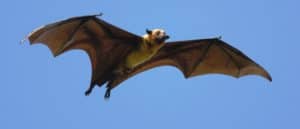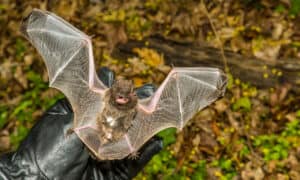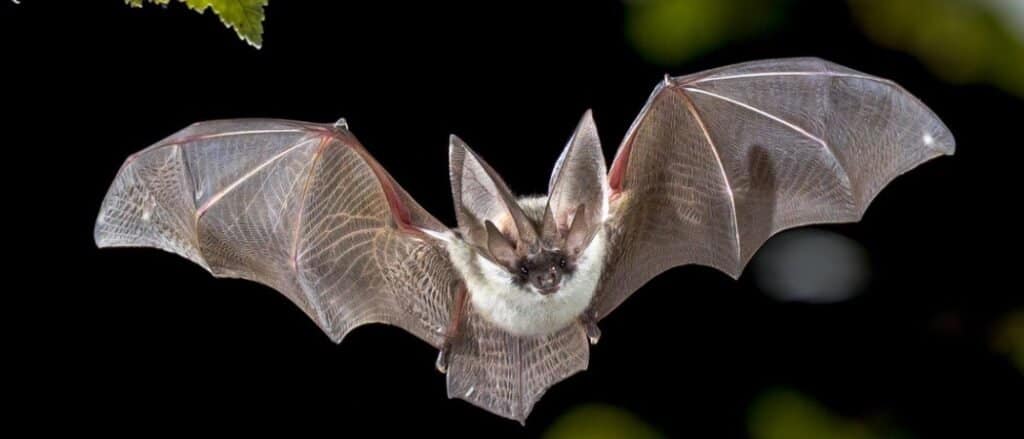
A single bat can eat up to 1,000 mosquitoes in a single evening – making their presence highly desirable and one reason to to build or buy a bat house that will attract and keep these amazing mammals safe.
©Rudmer Zwerver/Shutterstock.com
Sometimes called sky puppies, bats are some of the cutest creatures on earth. Although humans often associate these winged wonders with Halloween, horror films, and other ominous events, bats are truly mesmerizing and important beings. As the only mammals in existence who can sustain flight (flying squirrels merely glide, for instance), bats control pests, pollinate plants, facilitate agriculture, and play a crucial role in balancing and maintaining ecosystems across the globe.
In terms of the good deeds they perform, bats pack quite a mighty punch in a very tiny package!
So how can we attract bats to a bat house? Let’s explore seven easy steps to give bats somewhere safe and inviting to call home…
Why Attract Bats in the First Place?
First, let’s discuss why we would want bats to surround us and then we can talk about how to make it happen. For one, attracting bats to bat houses near our own homes is one way to support these amazing animals. It also means saying goodbye to pesky mosquitoes and dangerous pesticides (since bats control insects on their own) while saying hello to our favorite fruits.
See, bats are voracious eaters. As nocturnal beings, they can consume vast quantities of insects at night – namely those entirely-dreaded-blood-sucking mosquitoes. In fact, a single bat can consume more than 1,000 of these pests an hour. To put this number into perspective, a typical colony of 75 bats has the potential to devour a staggering 75,000 mosquitoes within just 60 minutes! Such a remarkable rate of consumption highlights just how significant bats are in protecting us from mosquito-borne diseases and illnesses. Put another way…bats are our little superheroes!
They are also great friends to farmers and agricultural processes – reducing the need for chemical pesticides, minimizing crop damage, and lowering the cost of food production. Furthermore, guano (bat droppings) has long been a valuable natural fertilizer that contains essential nutrients like nitrogen, phosphorus, and potassium, which enrich the soil and enhance plant growth. Historically, we have mined guano as a potent organic fertilizer. How cool is that?
But Wait, There’s More!
If all of that weren’t enough already… bats are also vital pollinators for numerous plants. Bat species who feed on nectar inadvertently transfer pollen from one flower to another – assisting in the reproduction of various fruit trees and night-blooming flowers. The pollination services bats provide are essential for the production of some of our most beloved fruits, including mangoes, bananas, and avocados. It may be hard to believe, but these staples would not exist without our chiropteran helpers.
Moreover, by eating fruits and later excreting their seeds in different locations, bats help plants colonize new areas, regenerate forests, and support the overall health of entire ecosystems. For this important work, we owe them a huge debt of culinary and environmental gratitude. So thank you, bats!
In short, bats perform amazing tasks and are worth buttressing in any way we can. At the very least, we can give them a roof over their heads by doing these seven easy things…
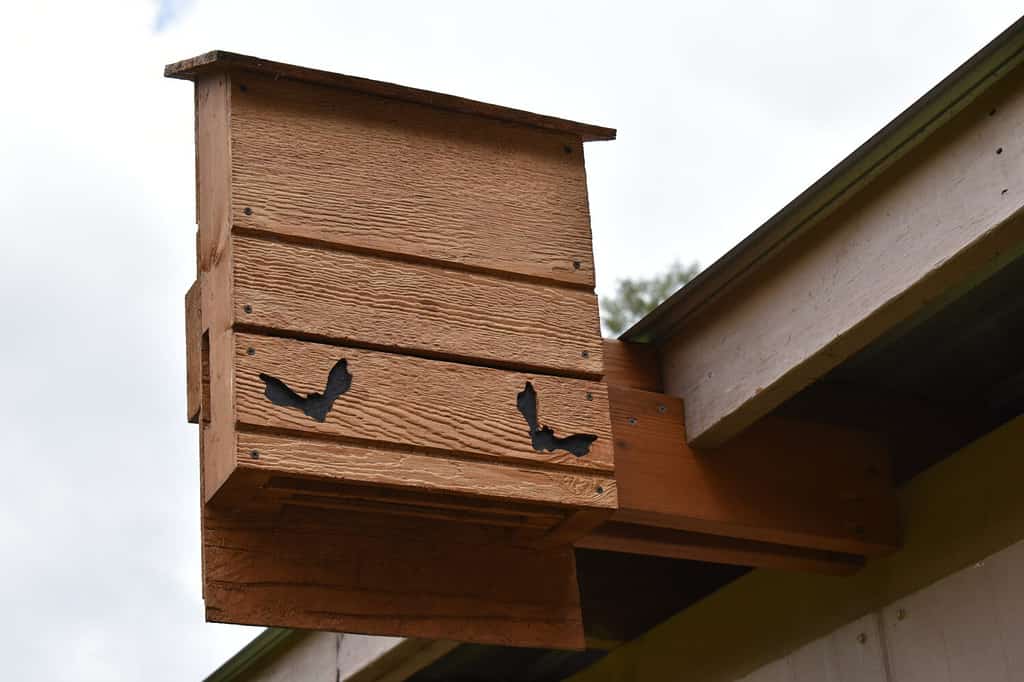
©LaidBackMattsPhotography/Shutterstock.com
1. Patience
First, bats take their own time to find the perfect home. Unfortunately, they are not all the same, either. Different bat species have varying preferences for roosting sites and some may be more inclined to use bat houses than others. Nor can their process for moving in really be rushed or forced. That said, it can take a long time – even up to two years – for a bat house to welcome any residents whatsoever! One survey suggests that 60% of all reported bat houses are eventually inhabited, but claims that it can take between three to five years for bats to find your bat house. Still, experts largely agree that if your bat house remains uninhabited after a two-year span, it may be time to relocate it.
No matter what, wooing bats is not an overnight process. It will take some time. So once you’ve installed your bat house, sit back and relax for awhile. Don’t give up too quickly!
2. Location, Location, Location
Just like most of us, bats are looking for prime real estate. Despite their cultural alignment with vampires – and the name vampire bat to describe a specific species – bats love the sun and prefer warm roosting spots. Your bat house should preferably sit somewhere that receives at least 6-8 hours of direct sunlight each day. For these reasons, houses mounted on trees are not recommended because they provide too much shade. Worse, they offer easy access to predators. For optimal sun exposure and warmth, orient the bat house to the south or southeast.
Homes are meant to shelter and protect – and this is the case with bat houses, too. Ensure you place your bat house at least 10-15 feet above the ground to accommodate bats’ flight behavior – allowing bats to drop down safely before taking flight. This ensures they can descend without encountering predators, like cats and raccoons.
Finally, make sure the house is as stable as possible and won’t sway or rock in the wind.
Oh! And while you can install bat houses at any time of the year, you will have a much better chance of bats using them during the first summer they are installed. Bats do migrate in the winter, so having your bat house all ready to go before they return in the spring will help them move in sooner.
3. Provide a Water Source
Obviously, bats need a water source for drinking and foraging. If possible, place your bat house near a pond, stream, or other water body. If you do not live near natural bodies of water, you can create one – using a shallow container with sloping sides or a birdbath – and then maintain the water at a depth of 1-2 inches. Regularly clean and change the water. Oh, and only add non-toxic treatments, if or when needed. Also, place the water source in a partially shaded area. Ensure nearby perching spots and consider adding dim, indirect lighting for nighttime visibility. Above all, respect their nocturnal habits and minimize disturbances while monitoring the water source so your bats feel safe.
4. Mood Lighting:
If you want to woo bats, you aren’t going to do it with stark artificial lighting. While they love the sun, they are sensitive to specific kinds of light, as are the insects they eat. The way bats respond to artificial light is a complex issue – one wrapped up in their nocturnality, foraging patterns, and their perceived danger to predators. But as a general rule, light pollution can deter bats from using the roost so keep your bat house in a fairly dark location.
5. Battastic Design
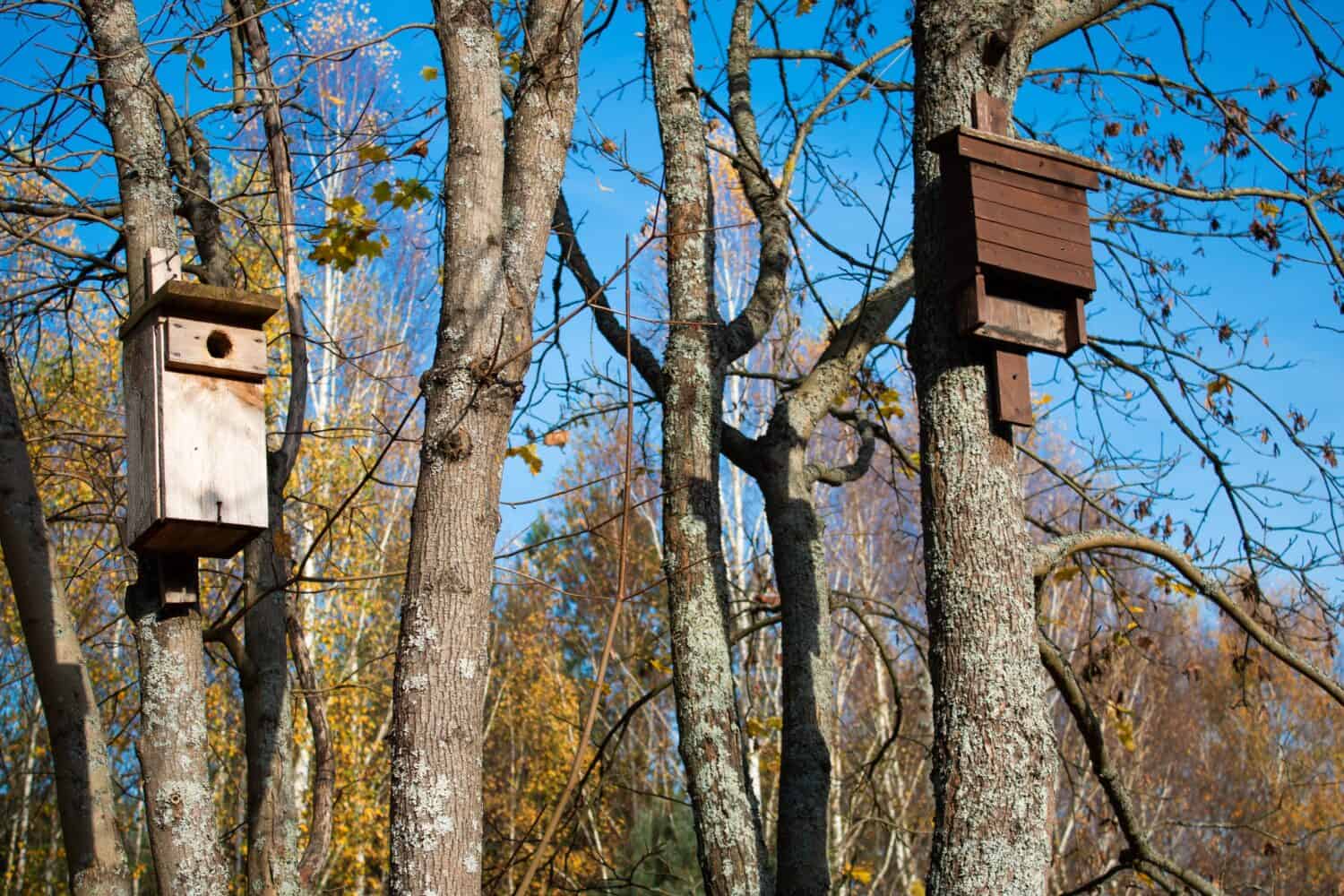
Be mindful of placing bat houses on trees which can expose bats to predators while providing excessive shade since bats prefer warmth.
©Bartosz Zakrzewski/Shutterstock.com
Don’t let anyone tell you bats don’t have their own style. All bats seek well-designed roosting spaces with proper ventilation and insulation – but different species prefer varying amenities and accommodations, of course. To this end, try to select a bat house with the appropriate size and design for the species of bats in your area and do some reconnaissance on how to please the bats in your neighborhood.
Bats are stage-five clingers, so to speak – so your bat house should have roughened interior surfaces or grooves to make it easier for them to hold on. Bat Conversation International (BCI) offers beautiful tips for assembling or choosing a bat house. And he National Wildlife Federation (NFW) provides super helpful, step-by-step instructions for constructing the coolest bat pad on the block.
An optimal environment for mother bats to raise their young includes consistently warm interior temperatures – ideally ranging from 80º F to 100º F during the summer season. Many people paint their bat houses a dark color on the outside to help lock in the heat. On that note, if you’re super lucky and end up hosting a maternity colony – squee! – please install a pup catcher. This device keeps babies from falling to the ground, which is sadly common when bat houses overheat during the summer.
However, please note that specific bat species have varying temperature preferences. For instance, the big brown bat tends to favor temperatures below 95º F, whereas the little brown bat can tolerate temperatures exceeding 100º F. Again, this is why it matters to gain some knowledge about exactly what types of bats reign in your region.
6. Maintenance
Contrary to what many believe have heard, bats are very clean animals. They groom themselves fastidiously and are rarely diseased. Only 1% of the population, for instance, has rabies.
In their spirit of cleanliness, keep the bat house tidy. Remove guano (bat droppings) annually when the bats have migrated for the winter. It is likewise ideal to examine the bat house regularly to verify that everything has remained in good condition. Otherwise, repairs will be necessary.
7. Plant Flowers and Avoid Pesticides
Remember: if you want to attract bats, insects are an important part of the equation. Bats need something to eat, after all. They exude tremendous energy flying and must have proper sustenance to survive. Transforming your garden into a nighttime haven will help nourish them. Utilize the enticing aromas of fragrant flowers, herbs, and night-blooming plants to draw in nocturnal insects – thereby creating an irresistible buffet for bats. The greater the insect population, the more successful your garden’s nocturnal charm will be. Consider introducing thyme, evening primrose, dahlia, French marigold, raspberries, or honeysuckle to your garden. Keep in mind that lighter-colored blossoms also enhance your garden’s chances of becoming a bug magnet, which in turn, attracts bats.
Finally, and this is key: it is never a good idea to use pesticides near or around a bat house. These harmful chemicals can sicken bats both directly and/or indirectly. Like all mammals, bats can ingest or breathe in particles or dangerous fumes. And pesticides will most likely contaminate the insects that bats prey upon, poisoning their food supply at the source.
Moreover, pesticides often enter the food chain, causing secondary poisoning in bats and other wildlife. In some regions, using pesticides near bat roosts may breach laws meant to protect them and their habitats. Always rely on natural pest control to create a bat-friendly respite.
| Steps to Attract Bats to your Bat House | Tips and Suggestions |
|---|---|
| 1. Patience | Once you set up your bat house, it can still take 1-5 years for bats to find their way home. So don’ be discouraged! If you do not have bats after 2 years, try re-locating the bat house. |
| 2. Find an Ideal Location | Place your bat house where it will get direct sunlight for 6-8 hours per day – preferably facing the south or southeast. Make sure it is situated at least 10-15 feet above the ground to protect bats against predators. And finally, install it during the spring so bats can find it by the summer. |
| 3. Give your Bats some Water | Bats need water so it is ideal to place your bat house near a pond or stream. Otherwise, create a body of water for them by using a shallow container with sloping sides or a birdbath. Be sure to place the water in shade and maintain it at a depth of 1-2 inches. Place dim or indirect lighting around the water source and clean and change the water frequently. |
| 4. Avoid Artificial Lighting | Bats do not like harsh artificial light, so avoid using LED and other artificial lights nearby. |
| 5. Design is Key | Carefully research the bats in your area to figure out their preferences and design or buy a bat house tailored to their needs. Be sure the internal temperature remains between 80º F to 100º F during the summer season. Also, get a pup catcher to protect babies! |
| 6. Maintenance | Keep your bat house clean and repair anything that might cause harm to the residents. |
| 7. Avoid Pesticides and Plant Flowers | Never use chemicals for insect control – in fact, plant flowers that attract them so your bats have something to eat! |
The photo featured at the top of this post is © iStock.com/nymphoenix
Thank you for reading! Have some feedback for us? Contact the AZ Animals editorial team.



